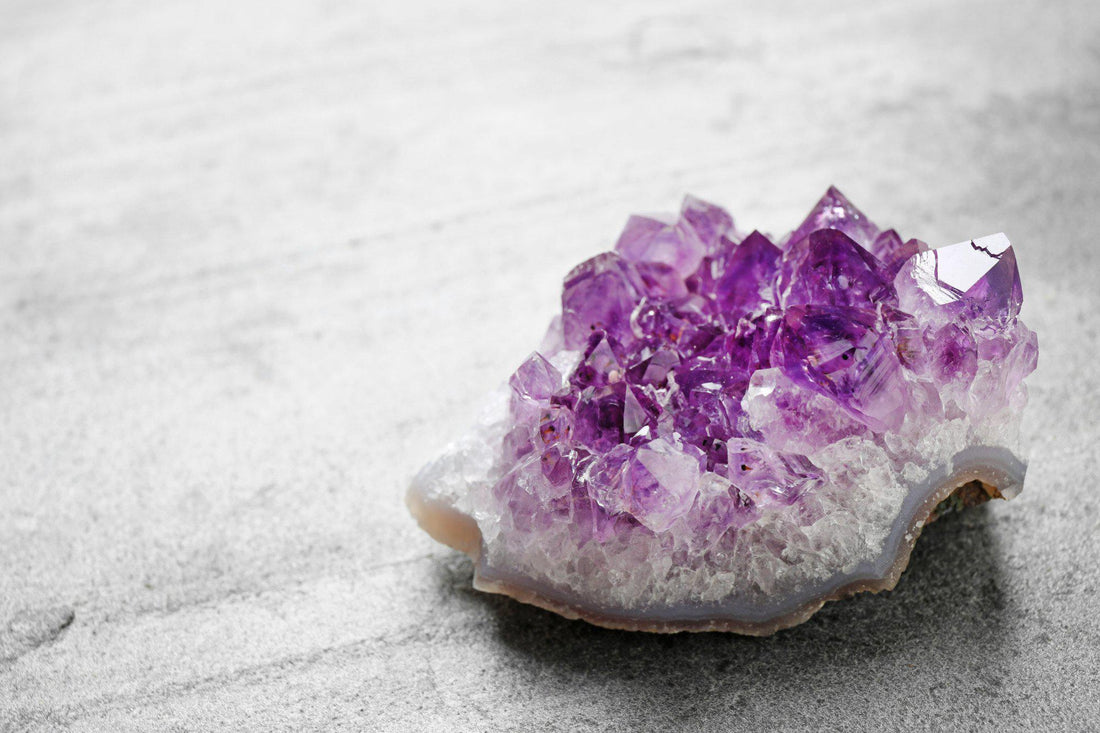
Amethyst: Exploring February's Birthstone
Share
Known for its vibrant violet color, discover the history, meaning, and healing properties of February's birthstone amethyst.
Amethyst is just purple quartz, right? Yes...and no. There's the widely available amethyst, and then there's gem amethyst, which is of a higher quality. It's also rarer and tends to cost more because of this.
No matter which grade of amethyst you're into, it's more than just a variety of quartz. It has its own history, its own meaning, and even healing properties.
Keep reading to learn how amethyst can be more than an accessory.
Amethyst: A History
The Ancient Greeks believed that amethyst could keep someone sober. Because of this, they also believed that amethyst was symbolic of clear-headedness, and therefore prowess on the battlefield.
The reason the Ancient Greeks associated these aspects with amethyst is because its violet color made them think of grapes, and the god Dionysus, who among other associations, was the god of wine.
But the divine connections to this crystal don't end there. Early Christians identified amethyst with Christ.
Amethyst jewelry was also associated with regality. Purple was a difficult color to reproduce and required a special plant to dye fabric. Therefore, as long ago as the Ancient Roman Empire, purple was considered a color reserved for the richest and most powerful.
This color association survived the fall of Rome and continued well into the Medieval and Renaissance eras. At times, it was even illegal for non-royals to wear purple.
Amethyst gemstones were often worn by rulers and even found themselves set into the Crown Jewels.
Once they were more common, they started to appear in jewelry outside of palatial settings. They were frequently used in Art Deco jewelry.
Whether rare or common, amethyst as a vast history that inspired deep cultural and religious meaning. Keep reading to learn about what amethyst has meant--and continues to mean--to various groups.
What Does Amethyst Mean?
Now get this--given what you now know about Ancient Greek beliefs regarding amethyst, will it surprise you to learn that the name for this crystal comes from the Greek amethystos, and that this word means to cure or prevent drunkenness?
In addition to being a birthstone, amethyst is also a traditional gift for a sixth wedding anniversary.
Amethyst is also associated with both strength and wit. You can see why--in addition to its violet hue--rulers wanted to deck themselves out in amethyst. What monarch wouldn't want to be seen as both strong and clever?
Catholic members of the clergy revered amethyst not only because of its association with Christ, but also because it symbolized both celibacy and piety, two traits they're expected to embody.
Feng Shui prizes amethyst as a bringer of wealth, if placed properly in a space.
People often meditate with amethyst. Associated with the crown chakra, this crystal is thought to enhance intuition and communication with the Universe or spiritual elements.
All around the world, throughout history and well into the present day, amethyst is used not only because of its beautiful color, but for the meaning behind the crystal as well.
In addition to these meanings, amethyst has long been thought to possess healing properties. Keep reading to learn about how this crystal is prized for these traits.
Paging Dr. Amethyst: Healing Properties
Whether you believe your amethyst pendant will heal you physically or not, it's interesting to think about the healing properties long believed to be granted by this variant of quartz crystal.
Amethyst is believed to cure pain. Wearing amethyst is thought to alleviate pain in the body. For those suffering from chronic pain, amethyst can make a nice addition to their jewelry collection because it can provide relief and look great at the same time.
This crystal is also believed to offer protection from harm. While not a healing property in the sense that in this case, you wouldn't have to wait until something's wrong, we're discussing it here because it's like taking a daily vitamin. You do so in a preventative way.
Because of its association with the crown chakra, and its use in meditation, amethyst is thought to clear negative thoughts. It can, therefore, decrease stress and anxiety. Stress and anxiety produce hormones in the body that, when present in high amounts over long periods of time, can be harmful.
For anyone who suffers from anxiety or panic disorder, amethyst can act in a healing way as well as preventative.
Perhaps due to its ability to clear negative thoughts, or perhaps for other reasons, amethyst is thought to cure insomnia. To wear jewelry to bed may feel odd though, so in order to benefit from amethyst's sleep-inducing healing properties, you could try sleeping with it under your pillow, or hanging from your bedpost if you have a pendant.
Long before ibuprofen, long before sleep aids, long before anti-anxiety medicine, people used amethyst to heal their minds and bodies--and they still do today.
Get Your Amethyst
Amethyst makes a great gift for a loved one--or yourself--if you want to celebrate being born in February. But it's also a great gift for anyone born in another month, too. With red and blue hues (the colors that make up purple), amethyst straddles multiple palettes--it's complimentary to multiple styles.
Also, with the history, meaning, and healing properties described above, amethyst is a multi-faceted gift in more than one way.
If you want to learn more about amethyst and the different types of jewelry available, drop us a line. We'd love to help you enjoy the history, meaning, and healing properties of this gem.
